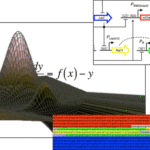AutoBioCAD: Full Biodesign Automation of Genetic Circuits
Synthetic regulatory networks with prescribed functions are engineered by assembling a reduced set of functional elements. We could also assemble them computationally if the mathematical models of those functional elements were predictive enough in different genetic contexts. Only after achieving this will we have libraries of models of biological parts able to provide predictive dynamical behaviors for most circuits constructed with them. We thus need tools that can automatically explore different genetic contexts, in addition to being able to use such libraries to design novel circuits with targeted dynamics. We have implemented a new tool, AutoBioCAD, aimed at the automated design of gene regulatory circuits. AutoBioCAD loads a library of models of genetic elements and implements evolutionary design strategies to produce (i) nucleotide sequences encoding circuits with targeted dynamics that can then be tested experimentally and (ii) circuit models for testing regulation principles in natural systems, providing a new tool for synthetic biology. AutoBioCAD can be used to model and design genetic circuits with dynamic behavior, thanks to the incorporation of stochastic effects, robustness, qualitative dynamics, multiobjective optimization, or degenerate nucleotide sequences, all facilitating the link with biological part/circuit engineering.
Learn about our two Decals!
 Click here to find out more about our Fall Bioinspired Design Decal and our Spring Bioinspired Design in Action Decal – ALL MAJORS are welcome.
Click here to find out more about our Fall Bioinspired Design Decal and our Spring Bioinspired Design in Action Decal – ALL MAJORS are welcome.Berkeley BioDesign Community
 Click here to learn about the BioD: Bio-Inspired Design @ Berkeley student organization or here to signup for more info.
Click here to learn about the BioD: Bio-Inspired Design @ Berkeley student organization or here to signup for more info.Search
Student Login




I imagine that the neurological circuits underlying these processes are governed by both 2d spacing maps with their brains as…
to reduce the impact of car accidents, it may be possible to study the force diverting physics of cockroaches to…
you see this type of head-bobbing stability in many avian creatures related to pigeons like chickens. the head ability to…
not like they taught horses how to run! this is an example of convergent evolution where both sea creatures and…
The brain functions in a similar way with neuronal connections. our brains are able to utilize the multiplicity of connections…